Intel D201GLY/D201GLY2 power consumption measurements and
performance
Power consumption
We recently got a
D201GLY /
D201GLY2 mini-ITX motherboard and we tested the power consumption
levels and CPU performance against similar motherboards. Since the D201GLY is a
very low cost motherboard it could be an excellent candidate for a variety of
low cost computing solutions.

For the test we
used a picoPSU-90
power supply because it has very high efficiency and it
also fits nicely into this motherboard. The picoPSU-90 is fed by a 12V power
supply. In line with the 12V input we placed a shunt resistor so that we can
measure and plot the current consumption. The graphs represent current
consumption, so you must multiply it by 12 in order to get the total power
consumption. For more information please see the
picoPSU-90 webpage

Basically, each division represents about 12watts. The setup (for the
D201GLY /
D201GLY2 and generic
VIA C7 motherboard) has a 3.5 drive with Windows XP. We measured the
drive (Seagate 7200RPM, 250Gb) separately and the average power consumption was
about 6 watts ([email protected] + [email protected]). The graph represents about 1 minute, from
power-ON to Windows coming up. As you can see, at the beginning there is slight
power spike, representing the HDD spinup and initial in-rush current from the
on-board BUCK converters, etc.
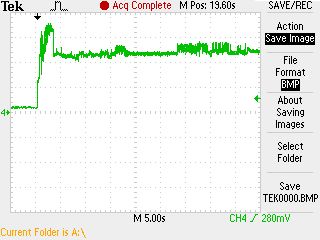
D201GLY @ 1.3Ghz + 512Mb DDR2 + 3.5 HDD power chart.
Average power consumption=~25watts for Intel D20GLY and 28watts for Intel
D20GLY2 / D20GLY2T, 6watt HDD included
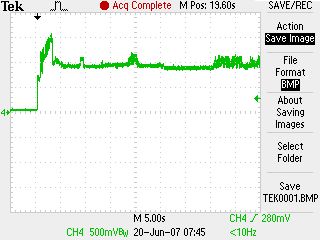
VIA C7 1Ghz, CN400 Chipset + 512Mb DDR02 + 3.5 HDD power chart
Average power consumption ~20watt, 6 watt HDD included.
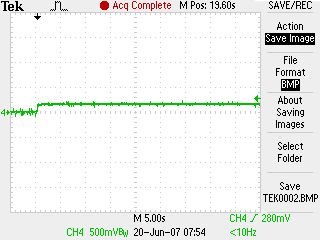
LX-800 board mini-ITX board from PCengines (www.pcengines.ch)
power consumption: About 5watts.
NOTE: In this setup no HDD was used, system booted from a Compact Flash).
Conclusion
The D201GLY is a rather green motherboard, consuming an average of only 25watts
and 28watts for Intel D20GLY2 / D20GLY2T. The board power consumption power
levels are rather close to the VIA C7 implementations, which are well known for
low power consumptions. Our CPU benchmark delivers the same message:
the Intel CPU perform better than VIA-EX CPU.
This system can be
powered by the picoPSU-90 with a 60watt AC adapter
. For applications where input voltage
cannot be a regulated 12V source (example: car batteries, automotive
applications),
the M2-ATX
Automotive
power supply will be a good candidate. NOTE: Do not use M1-ATX as the D201GLY
draws V(core) power from the 12V rail, therefore the M1-ATX might not work well
despite the fact that it is a 90watt PSU.
Intel D201GLY Benchmarks
We are often asked about performance differences between VIA and Intel mini-itx
Motherboard. In order to answer to this question Mini-Box.com
put some comparative information and performed a few interesting benchmarks of
processors on Linux, to show some of the differences. The power
consumption test has been performed with
picoPSU-90 power supply
because it has very high efficiency and it also fits nicely into
this motherboard.
We chose a suits of Linux benchmarks to illustrate the capabilities of those
processors. These tests were made using the iMedia
Linux 5.0.4 installation. and we used a 32-bit and 64-bit benchmark
during the synthetic analysis (bytemark tests). For the all of the
benchmark analysis we used the same driver version: cvs version of OpenChrome
VIA driver for VIA EX and Xorg SIS driver
for Intel motherboard. The both motherboard has been tested with the same Linux
kernel with no special optimization so that they can be replicated easily by
anyone using a similar configuration.For all of our tests, you will see 32-bit
binaries on 32-bit Linux kernels.
Below, you can see which configurations were used for the benchmark analysis.
|
Performance Test Configuration |
CPU: GenuineIntel Intel(R) Celeron(R) CPU processor 215 @ 1.33GHz 1333MHz
L2 Cache : 512 KB
OS : Linux 2.6.20-imedia-i686
C compiler : 4.1.2
MEMORY INDEX : 7.823
INTEGER INDEX : 7.328
FLOATING-POINT INDEX: 13.260
Baseline (LINUX) : AMD K6/233*, 512 KB L2-cache, gcc 2.7.2.3, libc-5.4.38
|
CPU : CentaurHauls VIA Esther processor 1500MHz 1500MHz
L2 Cache : 128 KB
OS : Linux 2.6.20-imedia-i686
C compiler : 4.1.2
MEMORY INDEX : 4.509
INTEGER INDEX : 4.320
FLOATING-POINT INDEX: 4.905
Baseline (LINUX) : AMD K6/233*, 512 KB L2-cache, gcc 2.7.2.3, libc-5.4.38
|
BYTEmark benchmark
First attempt is to take BYTE magazine's BYTEmark benchmark programs that are
free for download. The BYTEmark benchmark test suite is used to
determine how the processor, its caches and coprocessors influence overall
system performance, in our case the VIA-EX CPU and Intel CPU. The benchmarks
are designed to expose the capabilities of a system's CPU and were derived
directly, without algorithmic change, from the
BYTE web site. There are 10 tests in the BYTEmark test suite. Each uses
a well-known algorithm to analyze the full spectrum of processor performance in
the same way real-world applications do.
Below you will find the scores for the individual test that make up the BYTEmark
testing suite. Higher number is Better.
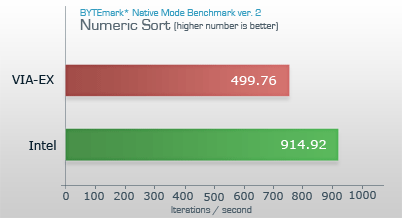
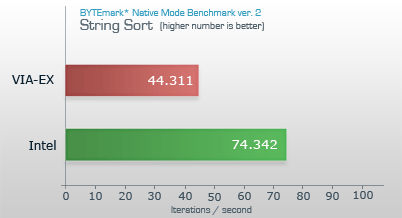
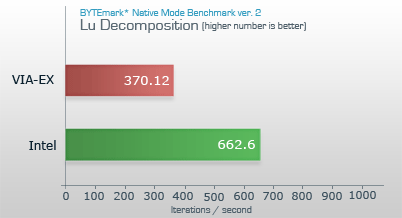
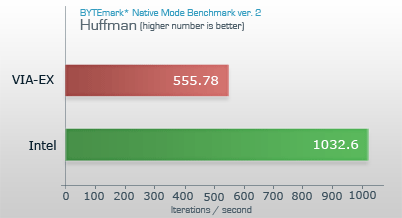
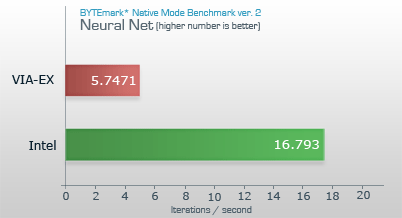

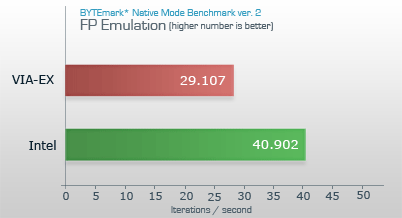

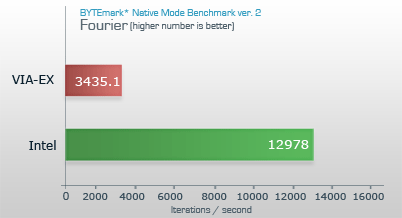
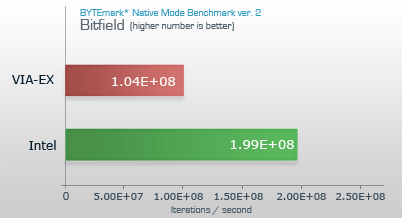
Numeric Sort, FP Emulator, Idea and Huffman are part of Integer Index
String Sort, Bitfield and Assignment make up the Memory Index
The other tests are part of FP Index
Opstone benchmarks
We also performed some Synthetic benchmarks, the
Opstone Benchmarks, a simple yet highly optimized mathematical-based
set of benchmarks. These tests are used to quantify the performance of a
computer's processor (CPU) in our case the motherborad CPU of Intel an VIA-EX.
Below is the we presented the Obstone benchmarks:
-
Vector Scalar-Product Benchmark:This benchmark is
measured in terms of "billions of floating-point operations per second"
calculated using vectors of various sizes where the mean performance values
across the range of vector lengths are reported. Both single and
double-precision floating point values are tested.
-
Sparse-Vector Scalar-Product Benchmark :Conversely
to dense vector solutions, sparse vectors are a specialized form of a vector
where only the non-zero elements are stored. These types of vectors are very
well suited for solving medium to large finite element engineering problems and
conjugate-gradient matrix solutions where a majority of the values in the
matrix row-vectors are zero.
-
Singular Value Decomposition Benchmark:Singular value
decomposition (SVD) is a very useful tool in the solution of near-singular
linear algebra problems. SVD is widely used in many engineering disciplines
although its strengths lie in the analysis of near-singluar systems and linear
least-squares problems.
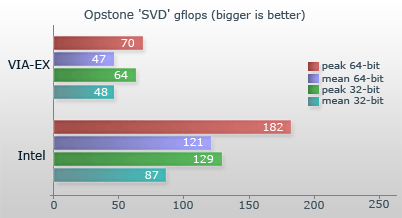

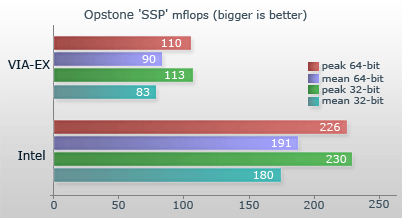
Lame MP3 encoding
We'll next turn our attention to another number-crunching activity. LAME MP3
encoding is popular with many of our readers C, for encoding digital music to
MP3 format. LAME 3.97 32bits (http://www.mp3dev.org/>)
Encoding as 44.1 kHz 192 kbps stereo MPEG-1 Layer III (7.3x) qval=2. We ran
lame on a 192MB .wav file using the command equivalent to the one below:
lame sample.wav -b 192 -m s -h - >/dev/null
Encoding time in seconds, lower is better.
Video Playback
The CPU Load has also been one of the more contentious issues with the
users. We ran video playback test into our system and register
the CPU IDLE (%) to determine the load of the processor. We ran Video
playback on the mPlayer for this 3 type of the files:
Video: 720x576 MPEG PES, Full NTSC
Audio: 224Kbit 48000Hz 2 Channels
Video: FFMEG H264 848x480 23fps 24bpp ( Apple Video Commercial GetAMac Security
)
Audio: AAC 128Kbps
Video: XVID 608x336 24bpp 23.9fsp 1019kbps
Audio: MP3 128Kbps 48000Hz 2 Channels
Higher is better.
Final thoughts
The VIA -EX and Intel CPU perform very well for what they were
designed. A straight comparison of processor against processor is not as simple
as it looks but if you look at these tests it is very clear that Intel CPU came
ahead. In conclusion, the Intel CPU perform better than VIA-EX CPU.
What the VIA and Intel motherboatrd has going for it is it's small
size and cool running processor and as you will see low power consumption. It's
reccomendable for home users, media serving, or anywhere a small quite machine
would fit in in generally for applications that don't require lots of power.
Note: We ran through all these benchmarks multiple times to reduce the
likelihood of an external factor.



















